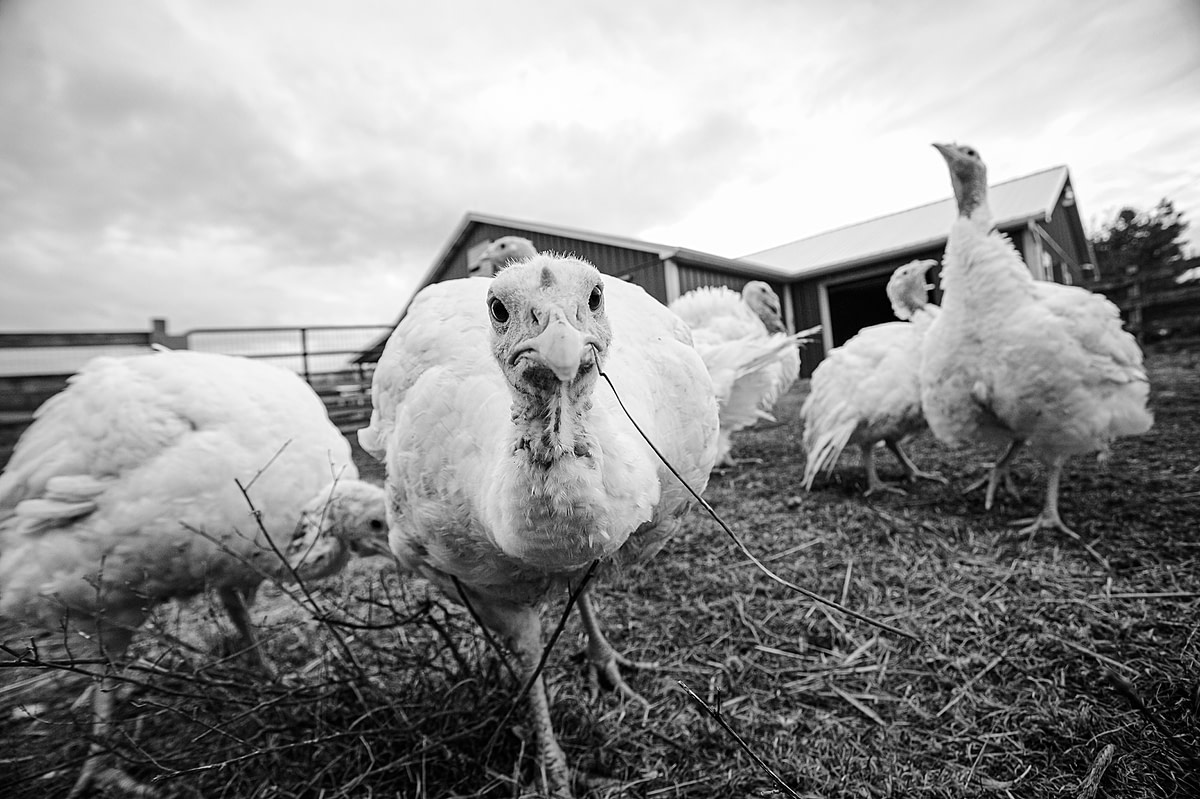Tofurky founder Seth Tibbott and rescued turkeys enjoy a meal and each other’s company at Wildwood Farm Sanctuary & Preserve. USA, 2021.
Jo-Anne McArthur / We Animals
Editor’s Note: This post was originally published on 21 November 2022 and has been updated for accuracy and to include new visuals.
46,000,000. This is the number of turkeys that Americans will slaughter to eat and give thanks this Thanksgiving. In the United States alone, approximately 223 million Turkeys are slaughtered for food each year, with the largest number consumed during the holiday season.
Ironically, given the number of turkeys consumed by Americans and the animal’s “significance” in American tradition, most consumers know very little about these birds and the lives they lived before reaching the table.
The Inner Lives of Turkeys
Turkeys are curious, intelligent and highly social birds with individual and unique personalities, communicating through a variety of easily distinctive and understood calls. The gobble, the spit and drum, the cackle, the yelp, the purr, and more are used to communicate a variety of circumstances, such as contentment, mating, calling birds together, encouraging young birds to follow, and remaining vigilant against predators.
In their natural wild habitats, Turkeys live in mature woodland, travelling in flocks while they forage for nuts, berries, seeds and insects on the forest floor. At night, they roost in the tree canopies above.
Rescued from becoming Christmas turkeys, Harold and his brother Fredrick explore the main shelter at Surge Sanctuary. UK, 2020.
Tom Woollard / We Animals
“I love seeing turkeys in the wild. Their black feathers seem iridescent and they can fly incredibly fast. In fact, that they can fly at all impresses me. I’ve met thousands of turkeys in industrial farms. They hobble along under the weight of their colossal bodies, which are genetically bred to grow rapidly and they suffer from the resulting physiological ailments, such as bumblefoot, a pus-filled abscess caused by a staph infection.” ― Jo-Anne McArthur, We Animals founder and animal photojournalist




From small-scale organic setups to large industrialized farming systems, turkeys who are bred for the plate live a different life. Domesticated turkeys are unable to fly and grow at unnatural rates causing their legs to collapse from their own body weight. On industrial farms, turkeys are crammed into warehouses with poor ventilation, resulting in injuries and respiratory problems. Domesticated turkeys can’t mate naturally due to their genetic alterations and massive size. Males must be masturbated by farm workers and the females forcibly inseminated.
Turkeys on industrial farms are raised to have massive muscling that prevents natural mating, so they must be artificially inseminated to breed. Poland, 2000.
Andrew Skowron / HIDDEN / We Animals
Another way to give thanks this holiday season
During a 2021 assignment in the US in collaboration with NowThis, Jo-Anne caught up with Seth Tibbott, Founder of Tofurky — America’s pioneering meat-free alternative — to find out more about the company’s humble beginnings and the growing demand for plant-based alternatives. Today, Tofurky produces thousands of pounds of plant-based products every day, to be exported to 25 countries. Thanks in part to companies like Tofurky, people can enjoy their Thanksgiving feasts without harming these curious and social birds.
Tofurky founder Seth Tibbott and rescued turkeys enjoy a meal and each other’s company at Wildwood Farm Sanctuary & Preserve. USA, 2021.
Jo-Anne McArthur / We Animals
“I’ve spent time with rescued turkeys at farmed animal sanctuaries. There, you get to watch them be autonomous, which is something that all animals love and crave, ourselves included. I absolutely revel in their curious and funny natures. My favourite interactions with turkeys are when they let me stroke the feathers on their abdomen and under their wings. They love it and start to preen themselves with pleasure. If you’re lucky, the young poults, who aren’t yet too heavy to fly, might decide to roost on your shoulder for a nap.” ― Jo-Anne McArthur
Meet Fred the Turkey
Discover the enchanting world of Fred Astaire, the tap-dancing turkey at Rancho Compasión animal sanctuary. Rescued from a Thanksgiving fate, Fred’s colourful displays and playful antics redefine our understanding of animal emotions. This short film by filmmaker Austin Meyer challenges our preconceptions and highlights the shared bonds between humans and our feathered companions.
A Thanksgiving message from our Founder:
“If how we treat turkeys and all farmed animals was common knowledge, I wonder if we’d be a little more hesitant to place them as a centerpiece on our festive tables. While companies need to be held accountable for animal abuse, that’s not going to happen if we keep up the demand. So grab that Tofurky, try the Beyond and Impossible burgers, try the amazing plant based cheeses and seafood and sauces! Holidays definitely feel more festive when nobody had to suffer for the celebration.” ― Jo-Anne McArthur
Inspire compassionate choices this holiday season. Explore more visuals like these.










